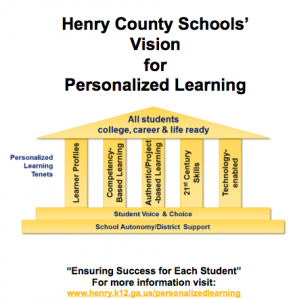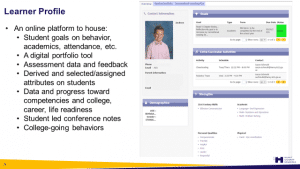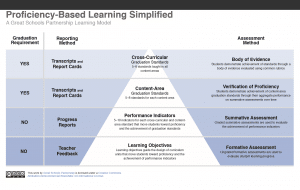Henry County Schools: Ensuring Success for Each Student
CompetencyWorks Blog
This post is part of a the series on Henry County, Georgia. This is the second of five posts. Read them all the way through: Post #1: Four Big Takeaways, Post #2: Ensuring Success for Each Student, Post #3: Scaling Strategies for Mid-Size Districts, Post #4: What All of This Means for Schools, Post #5: Impact Academy.
Henry County Schools’ (HCS) vision for personalized learning is captured in the phrase “Ensuring Success for Each Student.” To help people understand the components of the vision, it has been visually organized within the structures of a building. On the roof is the goal for “all students college, career, and life ready.” There are two steps indicating the foundation for the transformation: 1) school autonomy and district support, and 2) student voice and choice. The five tenets of personalized learning are the pillars holding up the roof:
- Learner Profiles and Personal Learning Plans
- Competency-Based Learning
- Authentic/Project-Based Learning
- Communication, Collaboration, Creativity, and Critical Thinking
- Technology-enabled

Each school has a different entry point and timeline for making the transition to personalized learning. Aaryn Schmuhl, Assistant Superintendent for Learning and Leadership, explained, “We think of the five pillars as the guard rails. Schools have the freedom within the five pillars to create personalized learning for their students. We avoid using the phrase design principles, as it can sound more like a mandate of what you have to do.”
To support schools in their redesign process, HCS is partnering with Mastery Design Collaborative led by Jeffery Tsang. MDC is providing guidance in the overall design process by meeting with teams from the school bi-weekly.
1. Learner Profiles and Personal Learning Plans: Learner profiles reflect students’ prior school performance and interests. Personal Learning Plans are co-created by students, their families, and HCS staff to help chart learning paths unique to each student.
Karen Perry, Special Projects Coordinator, used a personal story to explain the importance of learner profiles. “When my dad had cancer, we had to see lots and lots of doctors. And at each visit we had to retell the story to every doctor. Doctors didn’t necessarily talk to each other. That entire experience would have been better for all parties if there had been a central place, accessible to the patient, his family, and his extended care team, that housed all the important information needed to help him navigate that experience. Patients as well as students need to be the owner of their data and their stories. However, given that students are engaging with several teachers every day and the data is changing, we have to make it easier to keep it up to date.” She continued with another point, “Relationships take time and getting to know students takes time. We need to reduce the time it takes teachers to ramp up getting to know their students. We can do this through developing more intentional advisories as well as providing a dynamic platform to support student profiles and learning plans.” After looking at several products, HCS has decided to build their own platform. They are working with SRG Technologies to create an online platform that can capture information about past student progress, current student progress, and student aspirations for the future.

The essential features of the learner profiles and learning plans include: demographic data, historical information (attendance, grades, course completion, assessments), current information (strengths, interests, extra-curricular, instructional considerations, in-progress coursework, progress toward competencies, progress toward student-set goals, portfolios to hold body of evidence, student-led conference notes, capstone documents), and aspirational information (goals, pathway information, college-going behaviors, career information).
2. Competency-Based Learning
Building upon the ten principles of proficiency-based learning developed by Great Schools Partnership (GSP), HCS has developed a comprehensive infrastructure to guide instruction and assessment and ensure that students are proficient before moving on to the next level. This model identifies four different approaches to assessment:
- Formative assessment is used for learning objectives and standards.
- Summative assessment is used for performance indicators.
- Verification of proficiency over time is used to determine progress toward content area graduation standards.
- A body of evidence or portfolio is used to determine cross-cutting 21st century skills.

Graduation Competencies and Performance Indicators
HCS is using a four-level structure of cross-curricular competencies, content competencies, performance indicators, and academic standards and learning objectives.
The academic disciplines each have their own set of graduation competencies that are organized into performance indicators for elementary (K-5), middle (6-8), and high school (9-12). There are graduation competencies for each of these three bands based on the performance indicators; rubrics with scoring criteria using emerging, progressing, competent, and exemplary; and sample tasks. (You can find all of the academic graduation competencies, performance indicators, and scoring criteria here for each band of academic levels.)
There are also a set of graduation competencies for health and physical education, world languages, visual arts, performing arts, and career, technical, and agricultural education.
Reflection: Similar to many other schools in early implementation, it’s not clear if these are academic levels or grade levels. As we push ourselves toward teaching children in their zone based on their skill level rather than the grade level based on their age, we are going to have to become more adept at communicating the difference and how schools organize learning around each.
Academic levels are not directly tied to grade levels, but arise from them. HCS hasn’t made the decision to dissolve age-graded cohorts yet, but is leaning that way in several schools because it makes more sense to align the learning when students are ready instead of when they are at an age that may or may not be developmentally accurate for all students. Additionally, the state of Georgia is currently laying groundwork for Move on When Ready policies that will allow the district more flexibility with regard to students advancing upon mastery rather than in age-band cohorts.
At HCS the content coordinators are the “keepers of the competencies.” Mary Hastings, the advisor from Great Schools Partnership, explained, “It’s important to provide the content coordinators with resources. They need the opportunity to work with teachers to think through the implications of how they organize the units and create assessments. They need opportunity to figure out how to construct units using project-based learning.” Over time, the team at HCS are developing exemplar performance tasks as well as new protocols to guide operations, including ensuring assessments are high quality and support tuning processes. HCS has set precedent for creating district-wide assessments called Student Learning Objectives, and is now working toward developing a feedback process specifically aimed at improving the quality of feedback from assessments as well as increasing student agency through feedback cycles. A challenge of the assessment work lies in balancing centralization (district-mandated) and teacher-created tasks.
The implementation of the competency-based learning structure is still early. Teachers are becoming familiar with the competencies, performance indicators, and rubrics, and are beginning to design units. They are also starting to explore using new practices as they become comfortable. See the next post, Scaling Strategies for Mid-Size Districts, for an overview of the scaling strategy at HCS.
3. Authentic/Project-Based Learning
HCS is building its capacity to offer students opportunities to learn through projects and/or authentic (i.e., real world) settings. They are drawing from the Buck Institute’s resources to enhance project-based learning, as well as service-based learning training from National Youth Leadership Council (NYLC) and guidance from Diana Laufenberg of Inquiry Schools. HCS is training sustainability coaches to build local capacity to re-deliver training and coach teachers in PBL practices using local staff. HCS has found value in making use of high-quality resources that are readily available and adapting them for local use by schools. HCS emphasizes, however, that this tenet goes beyond PBL and focuses on real-world, authentic learning experiences of all types.
HCS Personalized Learning Project Facilitator and PBL/Authentic Learning task force leader Alison Norsworthy reflects, “Focusing on authentic learning is an approach to engaging students in real-world/authentic projects, crossing multiple content areas, and putting to use 21st Century skills that will prepare students for life. Our teachers and coaches are reporting that students are more engaged and show great enthusiasm for authentic learning experiences. We see this as a powerful tool that allows students to have a deeper understanding of the content, and research shows students retain the information they learn longer.”
4. Communication, Collaboration, Creativity, and Critical Thinking
HCS wants their students to graduate as self-directed, lifelong learners. Their four cross-curricular graduation competencies are communication, collaboration, creativity, and critical thinking. (You can find the performance indicators and rubrics for each here.) During their course of study in HCS, students will build portfolios of evidence to demonstrate mastery of the 4Cs, culminating in a senior capstone project that will be juried prior to graduation. Students in earlier grades will also demonstrate mastery of the 4Cs through defending promotion and exhibitions of their portfolios. The local business community has expressed enthusiasm for the focus on these skills as necessary for success in the workforce. In the schools, much of this work will be accomplished through an advisory process, similar to the work of the Francis Parker Charter Essential School in Devens, Massachusetts.
5. Technology-Enabled
In addition to the platform to support student profiles and learning plans, HCS is building the capacity to take advantage of online learning to deliver instruction and education technology to enrich learning experiences. Perry explained, “Our community doesn’t want a fully online experience for their kids. They are wary of too much screen time. So we are looking for ways that technology can enhance the experience and enhance the personalization. The Mastery Design Collaborative has been helpful in providing curated resources to the schools.
Assisstant Superintendent Aaryn Schmuhl said, “We trust our teachers to make smart decisions about what digital resources are necessary for kids to demonstrate mastery of our competencies. So, the decision to find the ‘best’ tool isn’t as important as having ways to capture student evidence of mastery. We curate what we believe are resources that are best in category and aligned with our learning competencies, but give teachers lots of freedom to use what makes sense to them. What we know about technology is that people use what they are comfortable with, and support and procurement needs to reflect some acknowledgement of that case. There are Mac fans and PC fans, Android vs. IOS, and on and on. It’s important that kids and teachers use technology to advance the cause of mastery competencies, not the use of particular piece of technology.”
—
By now, you are probably asking, how are they going to support fifty schools and 3,000 teachers to make this transition? Read Scaling Strategies for Mid-Size Districts to learn about their implementation strategy.